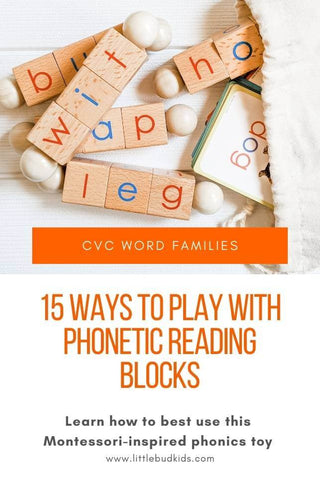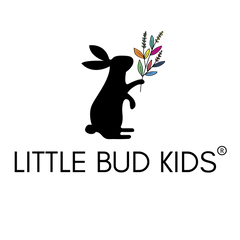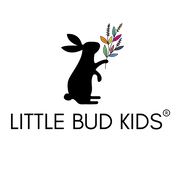Word Families & 15 Ways to Play with Your Phonetic Reading Blocks

Learning to read English is not a walk in the park. 🤔 English has so many different rules and exceptions that sometimes it's hard for beginner readers to keep everything straight and make sense of what they're reading. Letters often have multiple sounds, and then there are heteronyms (words that are spelled the same, but have different pronunciations and meanings). Just think about the word "read" which is pronounced two different ways depending on context!! 🤪 All this can be very confusing for a preschooler, kindergartener, or 1st grader learning how to read.
That is why learning "word families" and phonics first can help children observe predictable patterns that do exist in English. Word families (also called phonograms or "chunks") are basically a group of words that have a common pattern and pronunciation; they share the same combination of letters and they all rhyme because they have the same ending.
Think about the word family -at, and you'll get cat, mat, hat, bat, sat, pat. Learning that letters a and t together always sound like "at" makes it much easier to then blend different letters to its beginning to make new words. 💡 And why wouldn't we want to teach a method to our children that helps empower them and boost their self-confidence?
Our Spin-and-Read Blocks will introduce your child to the world of words through simple short-vowel based 3-letter words. With these wooden reading blocks, word families are brought to life and letter sounds are blended together in a very visual and tactile manner. These sensory blocks stimulates your child's need to learn in multiple ways - through touch, movement, balance, sight, and hearing. Little Bud Kids' Montessori-inspired phonetic reading blocks are the only Montessori movable alphabet blocks that come with accompanying flashcards allowing for full engagement through self-discovery, exploration, and self-correction. And yes, it is totally screen-free.
Want to learn more? Here are 15+ play ideas of how to use your blocks & flashcards.
- Basic spinning & blending: Start with the vowel A letter rods. Beginner readers will find the -at, -an, and -ag word families easiest to master since many of these words are already in a toddler's vocabulary bank. Spin the left or the right blocks, or both, and sound the letters out! Keep spinning to read out new CVC (consonant-vowel-consonant) words. Refer to an alphabet chart to refresh letter sounds.
- Real or nonsense words shout: Grab a wooden rod. Keep the right letter still while spinning the left letter. Read each new word and shout out whether it's real or nonsense. Now, switch the block that spins, and repeat. Keep track of the score and see how many real vs nonsense words you can get!
- Real or nonsense words writing practice: Grab a paper and a wooden rod. One column = real words. One column = nonsense words. Spin out new words on your wooden rod, and write down the words in their appropriate column.
- Flashcard match test: Look at the pictures on the flashcards. Review them, then see if you can spell it out correctly with your blocks.
- Flashcard mix: Remove the flashcards’ ring, mix the cards up, and see if you can sort them out by vowel! Remember, vowels are color-coded on the flashcards!
- Play with a friend: Grab a friend, your flashcard set and your blocks. One person have the blocks, and one person have the flashcards. This person will show the flashcard with just the picture (no word spelled out). Have your friend create that word with their blocks. Check to see if it's correct by flipping over the card.
- Object match: Create a word & find an object in the house that matches or act out the word.
- Word count: Create as many words as you can. Count them up!
- Rhyme them: How many words rhyme?
- Create a word family book: Get your papers, glue, and scissors out. Create a word family book (for example, -at). See how many rhyming words there are on your blocks. Write them down in your word family book along with any other rhyming words you can think of. Find pictures of them in magazines or on the internet, cut them out, and glue them into your book!
- Match race: Set out words on each wooden rod in a row on the floor. Have an adult hand you 1 picture that matches one of your rods. Run to the rods and pick the correct match! See how fast you can go!
- Dice throw: Pick one word family, then throw 1 dice. Rotate the left block by the # shown on the die. Write down the created word. Better yet, make a chart separating the real words from the nonsense words. Switch word families and repeat!
- Popsicle Story: Get 5 popsicle sticks. Write a letter vowel on each. Blindly choose a stick, take that rod and create 5 different words. Now, tell a short story using those words.
- Hit the word: Get your papers, blocks, and a small and soft ball you can throw. Create 5-10 words using your blocks. Write each word down on a separate piece of paper. Tape them up spread on a wall. Have a friend or parent call out one word. Throw your ball to the correct word!
-
Make puzzles: Find pictures of words from your blocks, and match them up with the written word.
Click here for a printable version of these ideas!
p/s Need even more ideas? When you purchase a set of Spin-and-Read Blocks, your blocks come with a free download of 25 pages of activity worksheets. When we designed this reading block set, we not just had your child in mind, but our two young children as well. Learn more about our blocks here and how they are the only blocks on the market that provide all you need to get your child started with reading. Cheers to happy reading! 📚


Muchas gracias. ?Como puedo iniciar sesion?
Thanks for the useful tips!
Leave a comment